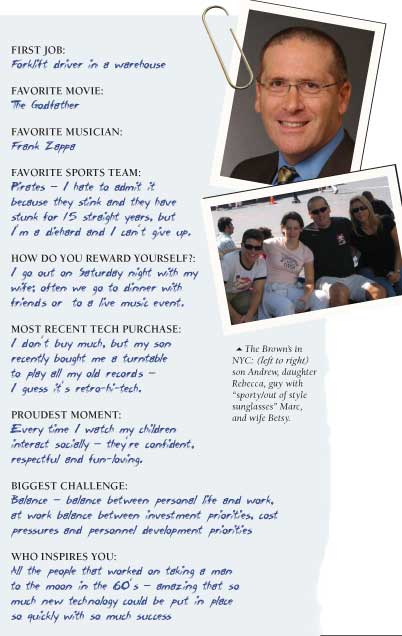Catching Up With Marc Brown, Vice President & CIO, Del Monte Foods
This month CGT Executive Editor Kara Romanow catches up with Marc Brown, VP and CIO of Del Monte Foods, to get his perspective on the challenges of managing a growing crosscategory product portfolio, as well as some best practices for handling mergers and acquisitions.
 | What keeps you up at night? How do manufactures and retailers better collaborate? Continued improvement in the shared ability to "sense and respond" to realtime events in our joint supply chain. This is all about continuous flow of information and increasingly aligned objectives and measures against which information is used. This must include more than POS category management data: Accurate and useful supply chain information: what's on shelf, what's in a warehouse, what's on promotion, etc. Trust will always be an important component for successful collaboration. Both trading partners need to know that the other will deliver on promises --- manufacturers in terms of on-time delivery, streamlined cost structure and improved products -- retailers in terms of store-level execution and category development activities. How important is consumer brand awareness and loyalty versus consumer company awareness and loyalty? Both are critical. Obviously, the Del Monte brand is an important piece of our consumer business. Consumers trust the Del Monte name and rely on us to deliver convenient, great-tasting, affordable and nutritious products for the entire family. Our individual brands are equally important and meaningful to our consumers. And, we market our individual brands and we are strong in the categories we compete in, but often we link our brands together because we have a lot of cross-category brand |
power. For example, our current cross-branded mega-event, "Make More of Mealtime," promotes our human food products line in collaboration with our retail partners. And our pet brands, from Meow Mix and Milk-Bone to Kibbles 'n Bits and 9Lives, also partner throughout the year.
You have been involved in several mergers and acquisitions over the past few years. From an IT perspective, what best practices can you recommend to companies experiencing a similar transformation?
First and foremost, get cross-business involvement before the deal is done. It is critical to do at least high-level planning of how you will integrate the business before the deal is closed. Given that most of these deals require some level of regulatory approval, there is a period of time between deal negotiation and signing, and when it is finally closed. While there are restrictions on the sharing of certain confidential information, there are plenty of activities you can execute that don't put you at risk. Second, we have had success setting a maximum timetable for integration, which is primarily driven by how much advance notice of change we need to provide to our retail customers. Our No. 1 goal is to protect retailer and consumer customers. We typically find 60 to 90 days as the necessary customer notification lead time depending on where in our business and fiscal cycle the deal closes. Third, we focus on establishing the going-in rules of engagement early. The rules of engagement are less between the two merging parties, but more so across internal business functions relative to target business policies, practices and processes that the merged entity will operate with. Once those are set everything else becomes much easier. Then, of course, there are standard project management techniques that need to be in place -- following disciplined work plans, regular status meetings, aggressive issue management and resolution and very significant training/testing. It's really more arduous than complex and if the methodologies and tools can be standardized, they can become a core competency for repeated use. CG
First and foremost, get cross-business involvement before the deal is done. It is critical to do at least high-level planning of how you will integrate the business before the deal is closed. Given that most of these deals require some level of regulatory approval, there is a period of time between deal negotiation and signing, and when it is finally closed. While there are restrictions on the sharing of certain confidential information, there are plenty of activities you can execute that don't put you at risk. Second, we have had success setting a maximum timetable for integration, which is primarily driven by how much advance notice of change we need to provide to our retail customers. Our No. 1 goal is to protect retailer and consumer customers. We typically find 60 to 90 days as the necessary customer notification lead time depending on where in our business and fiscal cycle the deal closes. Third, we focus on establishing the going-in rules of engagement early. The rules of engagement are less between the two merging parties, but more so across internal business functions relative to target business policies, practices and processes that the merged entity will operate with. Once those are set everything else becomes much easier. Then, of course, there are standard project management techniques that need to be in place -- following disciplined work plans, regular status meetings, aggressive issue management and resolution and very significant training/testing. It's really more arduous than complex and if the methodologies and tools can be standardized, they can become a core competency for repeated use. CG
